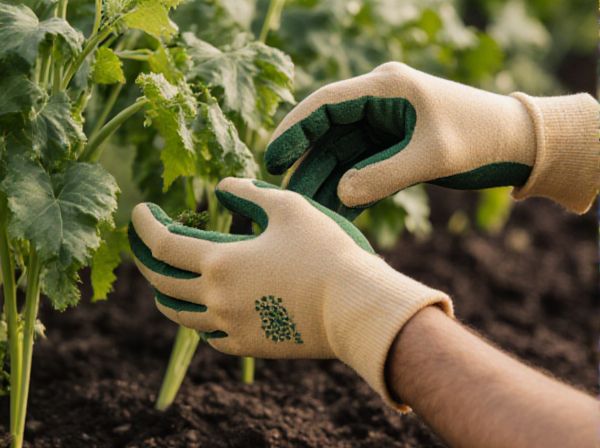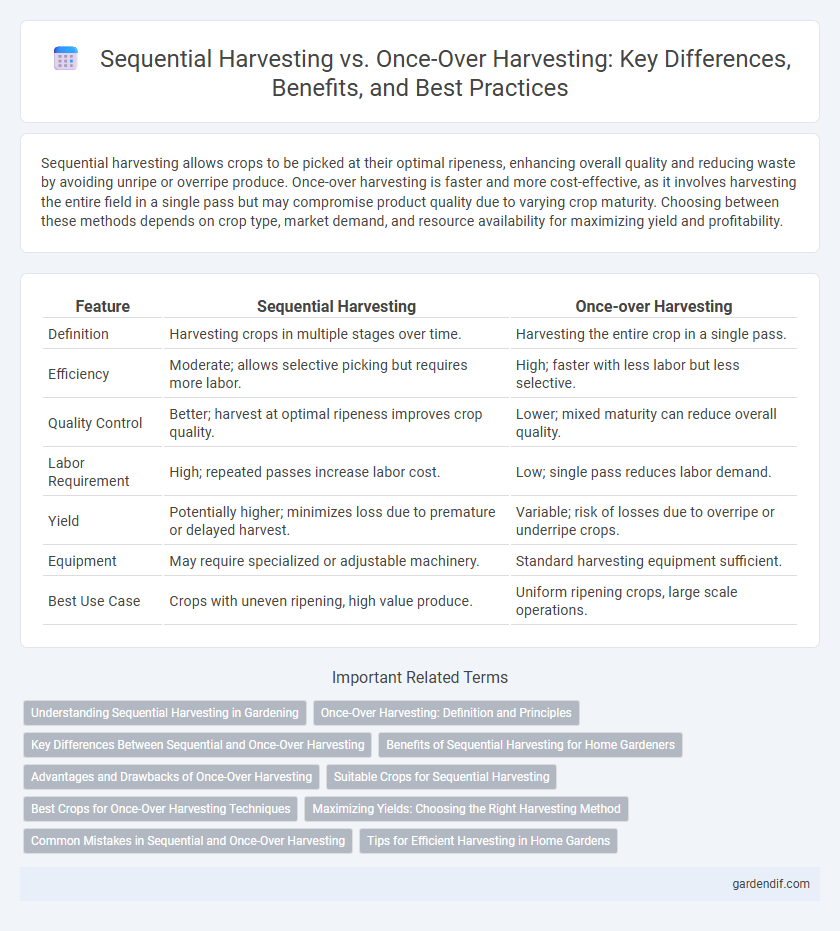
Sequential harvesting vs Once-over harvesting Illustration
Sequential harvesting allows crops to be picked at their optimal ripeness, enhancing overall quality and reducing waste by avoiding unripe or overripe produce. Once-over harvesting is faster and more cost-effective, as it involves harvesting the entire field in a single pass but may compromise product quality due to varying crop maturity. Choosing between these methods depends on crop type, market demand, and resource availability for maximizing yield and profitability.
Table of Comparison
| Feature | Sequential Harvesting | Once-over Harvesting |
|---|---|---|
| Definition | Harvesting crops in multiple stages over time. | Harvesting the entire crop in a single pass. |
| Efficiency | Moderate; allows selective picking but requires more labor. | High; faster with less labor but less selective. |
| Quality Control | Better; harvest at optimal ripeness improves crop quality. | Lower; mixed maturity can reduce overall quality. |
| Labor Requirement | High; repeated passes increase labor cost. | Low; single pass reduces labor demand. |
| Yield | Potentially higher; minimizes loss due to premature or delayed harvest. | Variable; risk of losses due to overripe or underripe crops. |
| Equipment | May require specialized or adjustable machinery. | Standard harvesting equipment sufficient. |
| Best Use Case | Crops with uneven ripening, high value produce. | Uniform ripening crops, large scale operations. |
Understanding Sequential Harvesting in Gardening
Sequential harvesting in gardening involves picking ripe fruits or vegetables continuously over a growing season, promoting prolonged production and reducing waste. This method optimizes nutrient use and encourages plants to keep producing by removing mature crops regularly. Unlike once-over harvesting, which collects all produce at once, sequential harvesting ensures a steady supply and better quality throughout the harvest period.
Once-Over Harvesting: Definition and Principles
Once-over harvesting is a method where crops are harvested in a single pass, maximizing efficiency by minimizing labor and operational costs. This technique relies on uniform crop maturity, ensuring that the entire field is ready for harvest simultaneously to optimize yield quality. Key principles include timing precision, synchronized crop development, and minimal post-harvest handling to preserve product integrity.
Key Differences Between Sequential and Once-Over Harvesting
Sequential harvesting involves multiple collection cycles that allow crops to mature at different times, enhancing yield quality and reducing waste. Once-over harvesting collects the entire crop in a single pass, prioritizing speed but often compromising on uniform maturity and increasing potential losses. Key differences include timing flexibility, labor intensity, and impact on crop quality and yield efficiency.
Benefits of Sequential Harvesting for Home Gardeners
Sequential harvesting maximizes crop yield by allowing home gardeners to pick mature produce continuously over an extended period, reducing waste and ensuring fresher, more flavorful fruits and vegetables. This method promotes efficient space utilization in small garden plots, as plants remain productive without being removed all at once. Harvesting gradually also helps home gardeners better manage pest control and plant health, leading to higher overall garden productivity.
Advantages and Drawbacks of Once-Over Harvesting
Once-over harvesting offers the advantage of increased efficiency by collecting all crops in a single operation, minimizing labor and machinery costs. However, it can lead to uneven crop maturity, reduced yield quality, and higher waste due to harvesting plants at different growth stages simultaneously. This method may also increase soil compaction and damage to fragile crops compared to sequential harvesting.
Suitable Crops for Sequential Harvesting
Sequential harvesting is highly suitable for crops such as tomatoes, peppers, cucumbers, and strawberries, which produce fruits or vegetables continuously over a growing season. This method allows selective picking of mature produce at different times, optimizing yield quality and extending market supply. In contrast, once-over harvesting is more appropriate for crops like grains and root vegetables, which mature uniformly and are harvested entirely in a single operation.
Best Crops for Once-Over Harvesting Techniques
Once-over harvesting techniques are ideal for crops like wheat, barley, and soybeans, where uniform maturity allows efficient single-pass collection. This method reduces labor costs and minimizes field traffic, enhancing soil structure preservation. Crops with synchronized ripening patterns benefit most from once-over harvesting, ensuring maximum yield quality and operational efficiency.
Maximizing Yields: Choosing the Right Harvesting Method
Sequential harvesting enhances overall crop yields by allowing multiple harvests of the same field, optimizing plant maturity and reducing waste. Once-over harvesting captures the entire crop in a single pass, minimizing labor costs but risking lower quality or quantity if some produce is under or overripe. Choosing the right harvesting method depends on crop type, market demand, and labor availability to maximize returns and efficiency.
Common Mistakes in Sequential and Once-Over Harvesting
Common mistakes in sequential harvesting include inconsistent timing, leading to uneven crop maturity and reduced quality, while overextension of harvest periods can cause crop loss and increased labor costs. In once-over harvesting, errors often arise from harvesting too early or too late, resulting in suboptimal yield and impaired product quality. Proper monitoring of crop development stages and precise scheduling are essential to avoid these pitfalls and maximize overall harvest efficiency.
Tips for Efficient Harvesting in Home Gardens
Sequential harvesting extends the harvest period by allowing vegetables like tomatoes and beans to ripen gradually, maximizing yield and reducing waste in home gardens. In contrast, once-over harvesting gathers all produce at one time, beneficial for crops such as potatoes and carrots that mature simultaneously. Gardeners should monitor crop maturity closely for sequential harvesting and use sharp tools for clean cuts to prevent plant damage, ensuring efficient and continuous produce collection.
Sequential harvesting vs Once-over harvesting Infographic

 gardendif.com
gardendif.com